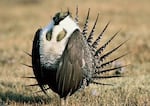
A male great western sage grouse.
U.S. Fish and Wildlife Service
A years-in-the-making plan to protect sage grouse from extinction is being reconsidered. U.S. Interior Secretary Ryan Zinke is bringing the plan, which took years to devise, back to the drawing table.
Zinke announced Wednesday the creation of a review team to reevaluate the state and federal sage grouse plans. He wants future efforts to highlight innovative conservation strategies and give more control to the 11 Western states that make up sage grouse habitat.
“A lot of these local communities, especially small businesses, just don’t think that they’ve had a voice,” Zinke said in a news conference.
Greater sage grouse are considered an “umbrella species” for shrub steppe habitat — so goes the sage grouse, so goes the sagebrush, and all the animals that live there.
That’s why government agencies, environmental groups, and ranchers came to the table after years of struggle to find a way to save the chicken-sized birds. The plans — to be implemented by the Bureau of Land Management — were meant as a compromise and to protect the most important pieces of sage grouse habitat.
For the ranchers who accepted the compromise, one of the key features was that it promised to avoid adding the sage grouse to the list of federally protected endangered or threatened species -- a listing that would have brought more onerous land-use restrictions to protect the bird's habitat.
But Interior Secretary Ryan Zinke said it wasn't enough, and that some people still aren't happy with each state's conservation plan.
"There is a lot of mistrust. My largest and most important task, quite frankly, is to restore trust that Interior can be a steward of our public lands," he told reporters on a conference call
Some states, industry interests, and grazing groups have sued the federal government over the current plans.
Zinke said the review isn't meant to ask the states to rework their sage grouse plans completely, but rather to "give an option to incorporate more variables," like captive breeding programs, West nile virus issues, and corvid predation.
Zinke would also like the sage grouse conservation plans to focus more on population numbers and less on habitat — a key distinction with the original plan. Sage grouse need large, open swaths of land to survive.
Wyoming Gov. Matt Mead and Colorado Gov. John Hickenlooper recently sent Zinke a letter saying a population-based conservation approach was "not the right decision." But other Republican Western governors have asked for more states to have more control in sage grouse conservation approaches.
A report on the review should be out in August.
There are many threats to sage grouse across its vast habitat range. Sagebrush country is said to suffer "death by a thousand cuts." The birds' habitat has diminished from increasing wildfires, encroaching juniper trees, oil and gas development, mining, and excessive grazing.
It's difficult to know exact sage grouse population numbers, but the U.S. Fish and Wildlife Service estimates somewhere between 200,000 to 500,000 sage grouse live across the range.
The sage grouse is considered an indicator species to the health of the rest of the landscape. Conservationists say protecting the greater sage grouse will inevitably help more than 350 other species that also depend on shrub steppe habitat — including mule deer, pronghorn, western burrowing owl, and pygmy rabbit.
In 2015, the government decided the sage grouse did not need federal protection across its range in 11 Western states because of what was dubbed an "historic conservation campaign."
It was a hard fought decision — one that an unlikely partnership of conservationists and ranchers championed. Environmental groups originally petitioned to list the sage grouse as endangered in 2002. In 2010, the U.S. Fish and Wildlife Service said it would consider listing the species.
That's when conservation efforts kicked into high gear — spurred on in part by concern from the oil, gas and mining industries and ranching interests.
Sage grouse conservation by government agencies, ranchers and environmental groups took many forms throughout the birds' wide range — and the government ultimately concluded those efforts were enough to protect the species.
The government's decision meant the Bureau of Land Management was in charge of implementing land use plans, specific to each state's critical sage grouse habitat.
At the time some environmental groups, like WildEarth Guardians, were unhappy with the decision not to add the sage grouse to the endangered species list.
"The sage grouse faces huge problems from industrial development and livestock grazing across the West, and now the Interior Department seems to be squandering a major opportunity to put science before politics and solve these problems," said Erik Molvar wildlife biologist with WildEarth Guardians. "The government's proposed plans fall far short of ensuring this iconic, imperiled bird is protected from the serious threats posed by fossil fuel extraction, grazing and other types of development.
Even with the criticism, the decision was seen as a possible path forward for other endangered species candidates — increased voluntary and local collaboration to avoid the possibility of more stringent restrictions from the federal government.
"With climate change and an expanding population, the stresses on our land, water and wildlife aren't going away," then-Interior Secretary Sally Jewell said in 2015. "But I am optimistic that we have shown that epic collaboration across a landscape, guided by sound science is truly the future of American conservation."
